Viti Essay
| CLOSE WINDOW |

|
University of Virginia |
|
Question: William Faulkner's fiction interests me particularly because of the project of continuing and expanding the same fictional world across multiple distinct works of art, with sometimes very different artistic and thematic projects. As someone with personal creative interests and aspirations of my own, the idea of creating a world to return to repeatedly is appealing, but the idea of revisiting the same characters in that world—of letting them populate each other's stories and grow and change across the narrative of the place, not merely the narrative of one particular project—is especially captivating. I decided to use Digital Yoknapatawpha to explore the arc of one such character across Yoknapatawpha County, to track his physical progress and progress through time throughout Faulkner's narrator. I choose Quentin Compson because of his central roles in two novels, The Sound and the Fury and Absalom, Absalom!, as well as several short stories: enough works to make his travel through the times and place of Yoknapatawpha County across Faulkner's career interesting. What I Did: I used DY's Character search function to identify all the works that Quentin Compson appears in. He appears in eight works, which in publication order are: The Sound and the Fury; "That Evening Sun"; "A Justice"; "A Bear Hunt"; "Lion"; Absalom, Absalom!; "Appendix, Compson"; and The Mansion. I originally used the "either" function, to rule in both works where he is discussed and works where he physically appears, but, interestingly, when I refined later to use only the "present" function, I discovered that Quentin is physically present in all eight of these works. However, he is only mentioned (in addition to his presence) in five of them: The Sound and the Fury; "A Justice"; "Lion"; Absalom, Absalom!; and "Appendix, Compson". I then hypothesized that Quentin's more significant appearances would be in those works where he is both physically present and mentioned, since when he is mentioned he is important enough to merit discussion by the other characters. Next, I used the MapIt function with each work to depict where Quentin physically goes within each work. I used the "Show Events: All" filter as well to get a timeline of roughly when Quentin's narrative actions within each work take place. Following are the screenshots of the results of these maps:
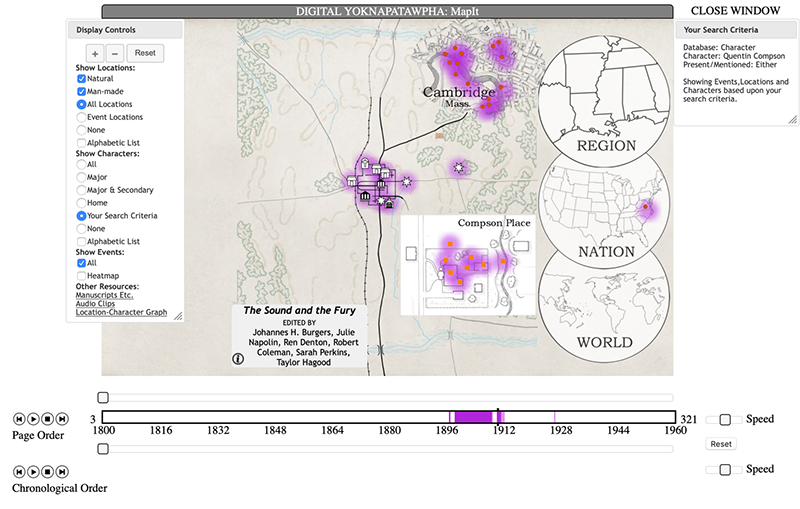 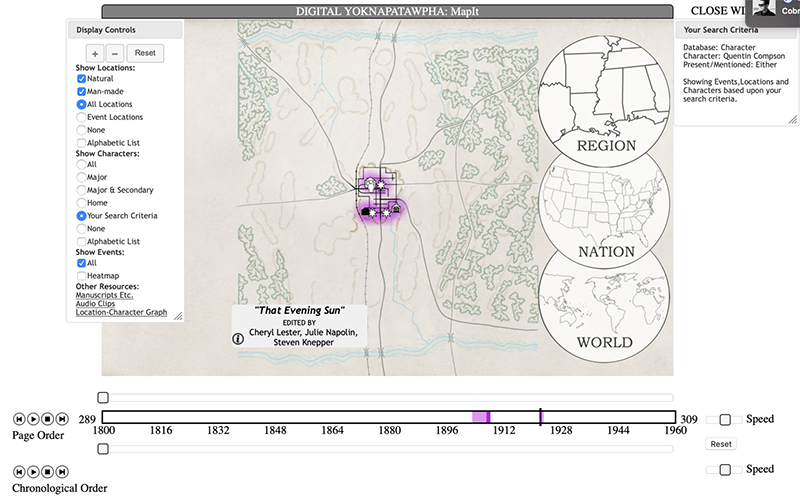 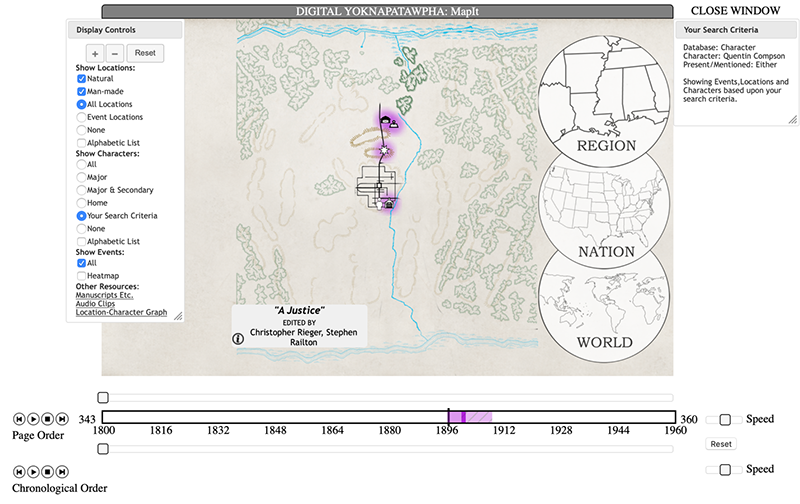 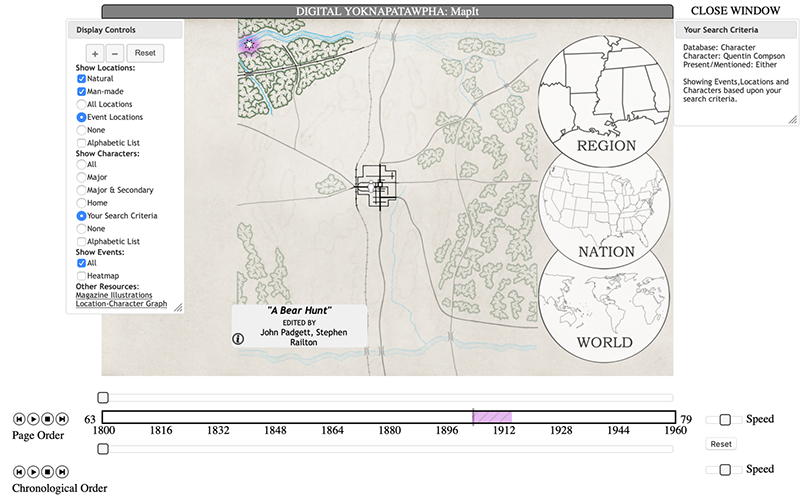 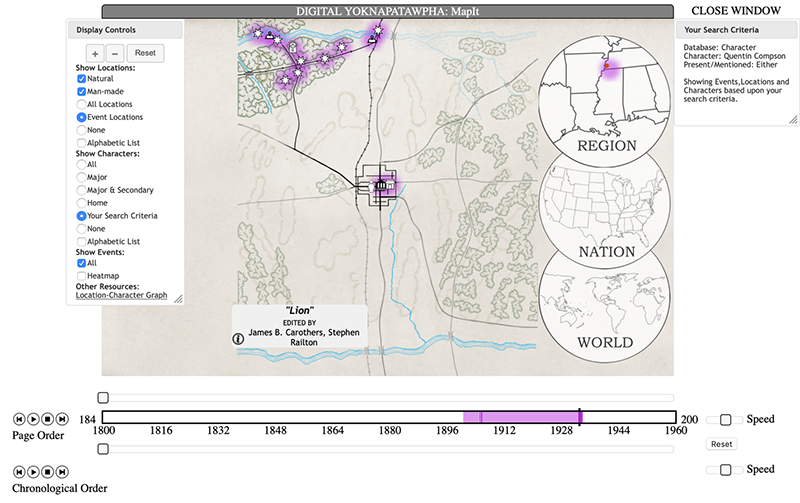  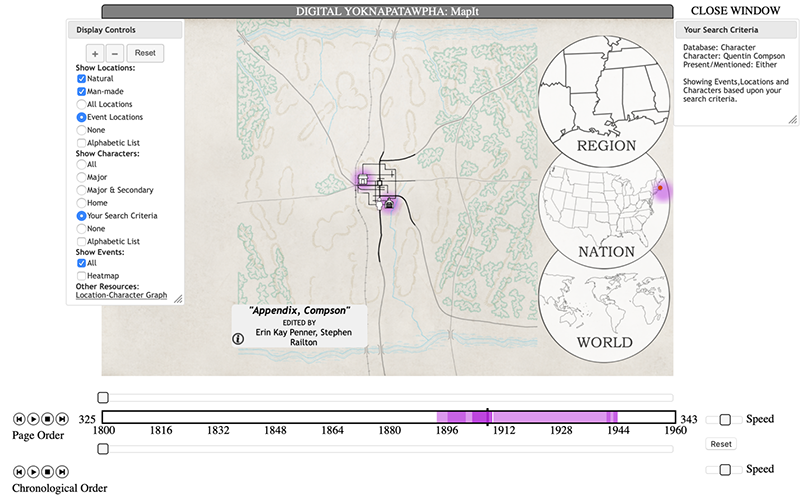 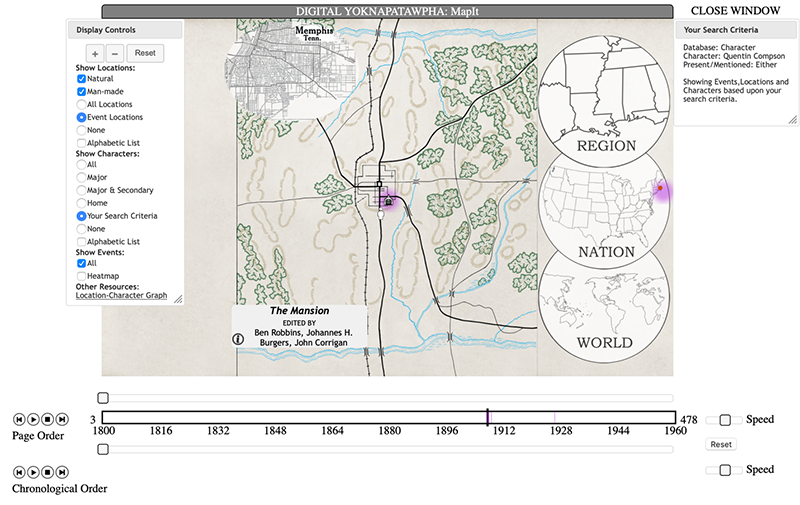 I also checked the characters and locations tool of the BiPartite Graph, filtering for Quentin Compson, either present or mentioned, and the characters and locations function of the Force-Directed graph. 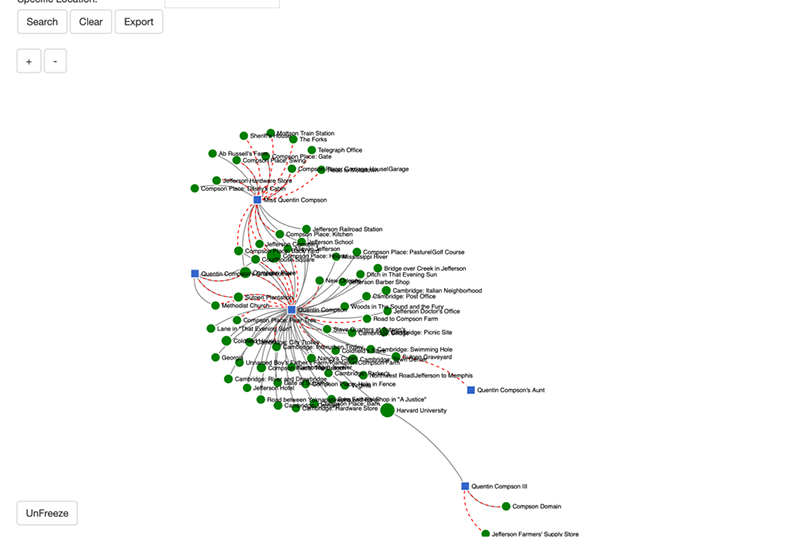 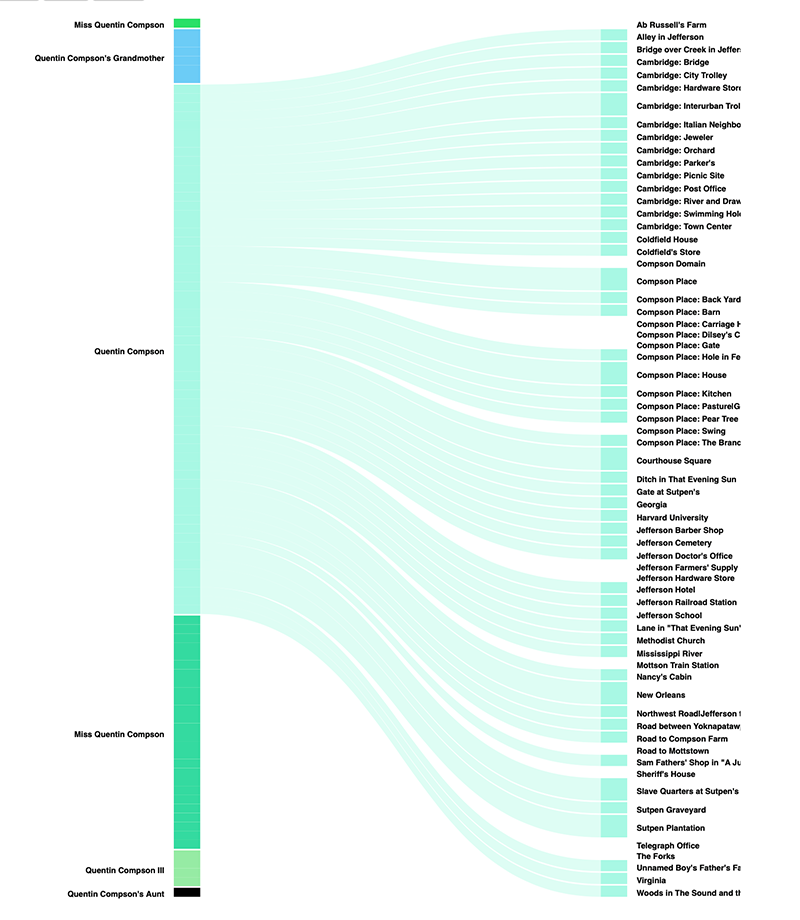 Conclusions: The maps illustrate some surprising parts of Quentin's journey through Faulkner's fictions. My original hypothesis, that Quentin's most significant appearances would be in works that he is both present and mentioned in, seems basically confirmed by looking at the maps with the exception of the absence of "That Evening Sun," in which Quentin is very present but not mentioned. Looking at Quentin's journey through time, the narrative of The Sound and the Fury reveals that Quentin commits suicide in 1910. However, the maps show that Quentin appears after 1912 in The Mansion; "Appendix, Compson"; "Lion"; "That Evening Sun"; and The Sound and the Fury. Upon closer examination of the events in The Sound and the Fury that appear after 1912, it is clear there are a few where either a different character's memories, or an appearance by Miss Quentin, are somehow shown as part of Quentin's story. Similarly, his appearances after 1912 in The Mansion and "Appendix, Compson" are simply mentions by other characters. This is interesting in that it reveals Quentin's lasting importance in the community (possibly because he is from such a prominent, if decaying, family), but it does not tell us more about Quentin's story. However, his appearance as the narrator in both "Lion" and "That Evening Sun" is problematic because both stories are told sometime after 1912, when Quentin should be dead according to the narrative of The Sound and the Fury. Interestingly, the same situation occurs when Quentin narrates the story "A Justice" after his death, but the fact that he is apparently narrating post-mortem does not appear on his timeline for "A Justice". The inconsistency of this narration is probably a result of the movement of Faulkner's imagination around in Yokonapatawpha, though in an audio clip linked to the map of "That Evening Sun", Faulkner insists that he never thought of the Compson children before The Sound and the Fury, and that all work featuring them must therefore have been written after that book. If the paradox of Quentin's narration was intentional, rather than simply an oversight, I'm not sure the sort of significance to assign to Quentin as an undead first-person narrator. In terms of Quentin's physical journey through life by location, the maps reveal that he spends almost all of his time in Cambridge, Massachusetts (when he goes to Harvard) and in Yoknapatawpha. In Absalom, Absalom!, Quentin spends some time imaginatively in a few other parts of the South, but the events tracker in DY seems to indicate that he never physically goes there (though I haven't read the story yet). He does physically appear on a train in Virginia in The Sound and the Fury, and in Memphis in "Lion" as well, but by and large, Quentin never seems to be exposed to much outside Yoknapatawpha. The maps make it seem as if Quentin is quite a homebody, especially considering that his one major trip outside his home bubble, to college at Harvard, results in such unhappiness as his death. Quentin's time in Yoknapatawpha is concentrated in Jefferson and the northwestern corner of the county, and he seems to never visit areas like Frenchman's Bend associated with poor white people. Though more textual evidence from multiple works is necessary to support this conclusion, this physical view of Quentin's life suggests that Quentin's identity was entirely focused on his role as a prominent member of the Jefferson community. Such a claim might support further argumentation that Quentin's obvious mental distress in The Sound and the Fury results from his removal from this identity and his perceived failures in this role, especially in regards to Caddy's purity. The BiPartite graph and the Force-Directed graphs were not really helpful in further visualizing what these findings might mean, because they both only show Quentin in relation to places and people he definitively interacts with, not in relation to all of Yoknapatawpha (or the world) generally. The tool that I really wanted to use, a map and timeline that plots one character's journey in every work so that they appear on the same map, I couldn't find anywhere on Digital Yokonapatawpha, if one exists. It might not be fruitful to do for every character, but interesting features of the arcs of certain major characters might be revealed by such a project. Citing this source: |
